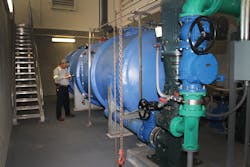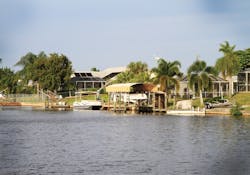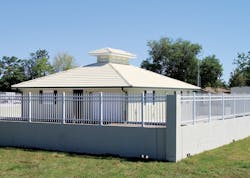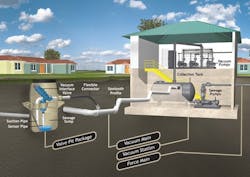Septic Sewer Swap
About the author: Steve Gibbs is a freelance writer who has covered wastewater infrastructure issues for more than 25 years. Gibbs can be reached at [email protected].
Southwest Florida has two popular attractions: golf and the Gulf of Mexico. The warm Florida climate and dozens of beautiful courses make it a prime destination for golfers from across the country. Sun-seekers love the beaches and anglers appreciate the wide variety of sport fishing available, such as grouper, snapper, tarpon and, for the very adventurous, barracuda.
The resources of the region also have made it popular for developers who have, over the past 50 years, built businesses and homes in the counties along the Gulf of Mexico north of the Everglades. An eight-county region stretching from Manatee County in the north to Collier County in the south has shown a population growth of more than 20% over the past decade alone; that is nearly a half-million people.
Problems, however, sometimes follow explosive growth. In the case of southwest Florida, so many new people in such a relatively confined area have created a water pollution problem that real estate developers in the 1950s and 1960s likely never considered: sewage. Many of the waterfront communities in the region have relied on septic systems to treat wastewater. Septic tanks worked fine until population density began to increase dramatically in the 1970s and 1980s. Mother Nature could not handle so many small home lots with septic systems, especially considering a geography of flat, sandy terrain with a high water table.
“Quarter-acre lots at sea level with septic tanks are bound to create issues,” said Gary Hubbard, P.E., utilities director for Charlotte County, Fla. “The tide affects the groundwater, so when sewage is present in groundwater), the tide takes some of it out into the canals and the bay.”
Charlotte County has more than 162,000 residents, many of whom have septic systems and live near rivers or canals, or adjacent to Charlotte Harbor.
Sewage seeping into local waterways led the Florida Department of Environmental Protection to declare Charlotte Harbor and the nearby Peace River to be “impaired waters.” High levels of nitrogen affect marine life and water sports, as well as property values. “From an economic standpoint, Charlotte Harbor is the lifeblood of the community; we have to protect it,” Hubbard said.
An Affordable Alternative
Eliminating the source of the nitrogen was an obvious solution to the pollution problem, but sewering an existing community is a difficult and expensive problem, especially in southwest Florida, where sandy soil and high groundwater make trench excavation and pipe laying problematic. Fortunately, Charlotte County could look to some of its neighbors for effective solutions to its sewer problems.
The Englewood Water District and Sarasota County are directly adjacent to Charlotte County. Over the past 20 years, each area has dealt with the issue of septic system abatement.
“In 1995 the Englewood Water District had us look into alternative sewer conveyance methods. One of them was vacuum sewer technology,” said Jonathan Cole, president of Giffels-Webster Engineers. Charlotte County hired his firm to help design and install its new sewers.
“Englewood was looking for alternatives to gravity sewers because they wanted to minimize the impact that sewer installation would have on [its] roads,” Cole said. “We bid the project both ways, gravity sewers and vacuum sewers. It turned out that AIRVAC vacuum sewers were more efficient both in terms of installation and with regard to operations and maintenance.”
Cole explained that installing vacuum sewer collection lines would be less disruptive and expensive than installing gravity collection lines. “Gravity sewers would have required that we dig up entire streets to create trenches 3 to 15 ft deep, then repave them afterward,” he said. “With vacuum sewers, we could install a smaller pipe in shallower trenches in the space between the pavement and property owner’s right-of-way [with] much less disruption and cost.”
Another important factor was the cost- effectiveness of lift stations versus vacuum stations. Cole noted that while a vacuum station typically is more expensive to build than a pumping station for a gravity sewer, a single vacuum station would do the work of several pumping stations.
“In Englewood, we could stretch out about 10,000 ft from a vacuum station. A gravity sewer would have required multiple lift stations for the same area. The efficiency of vacuum technology is just much better in these conditions.”
An added benefit of vacuum sewers is the ease of operations and maintenance it provides for utility workers.
“Once [operators] became familiar with the AIRVAC system, they realized they rarely have to come in contact with raw sewage,” Cole said. “With gravity lift stations the pumps are actually submerged in the sewage, so if there is a mechanical problem it gets very messy. Vacuum pumps are in dry air, so you almost never come in contact with sewage. The stations are clean and virtually odor free, so the working conditions are far better.”
As Englewood Water District was addressing its sewer issues, Sarasota County was watching closely. Its analysis yielded the same conclusions: Vacuum sewer technology was cleaner and easier to install and maintain. Sarasota County soon embarked on a multi-year, multi-phase project to replace septic systems throughout the county. Again, Giffels-Webster Engineers was involved in the design and construction. Since in 2003, Sarasota County has installed nine AIRVAC vacuum systems serving nearly 12,000 houses.
Cost/Benefit Factor
After approximately 20 years of staged construction, the Englewood vacuum sewer system is now virtually complete, with seven vacuum systems serving 8,500 houses. Sarasota County is in its 14th year of staged construction, with two more vacuum sewer systems to be installed over the next few years. Cole said that over that time, his firm has designed and installed approximately 1.5 million ft of vacuum line and 19 vacuum stations in the Englewood and Sarasota county areas, as well as other Florida communities.
“Vacuum sewer technology has really taken off in this part of the country,” Cole said. “We’ve done [AIRVAC] systems in Sarasota County, Martin County, Jacksonville and Tarpon Springs. The Englewood system has approximately 9,000 connections, so it is quite large. We’ve sort of specialized in vacuum sewers for the past 20 years.”
That work is helpful for the communities of southwest Florida, where the experience of Giffels-Webster is reassuring to both community leaders and taxpayers. It is a long-term effort; construction on the new sewers in Charlotte County began in 2009 and it will likely take several more years before the project is completed.
“Our goal is to provide sewer service to 30,000 users who now have septic systems. The project will likely span the next 10 to 15 years,” said Bruce Bullert, P.E., engineering services manager for the Charlotte County Utilities Department.
Charlotte County’s vacuum sewer initiative is being financed by a combination of property assessments and federal grants. Are the residents eager or reluctant to pay for new sewers?
“Change is always difficult, but I think we are about 50/50 between customers who want new sewers and customers who don’t,” Hubbard said. “We have a very good board of commissioners who are willing to address these hard issues. These are issues that have been known for years; it takes a lot of political will to solve the problem.”
[Visit Airvac's WWD Storefront]
What can the property owners in Charlotte County expect for their investment?
“We have to protect our resources,” Cole said. “If we lose our water quality, we’re done. I can say that the water around Englewood is much better these days. I think Sarasota County and Englewood both did the right thing by installing vacuum sewers. Whenever you do something new, people will be tentative and a little concerned. I’m pleased that in hindsight, vacuum sewers were the right decision for Englewood and Sarasota County, and I think it’s the right decision for Charlotte County now.”



